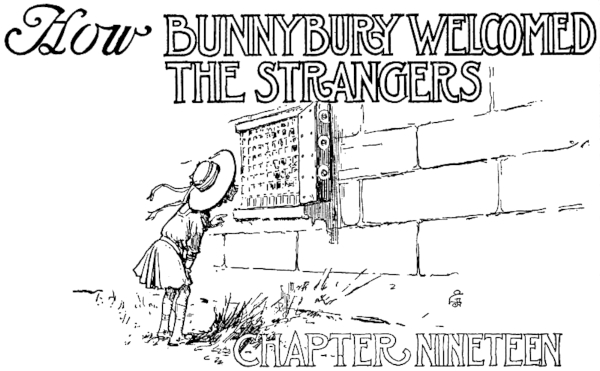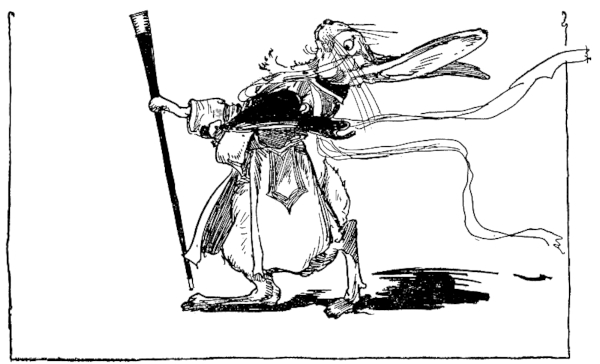| Web
and Book design,
Copyright, Kellscraft Studio 1999-2019 (Return to Web Text-ures) |
 (HOME)
|
 19. How Bunnybury Welcomed the Strangers Dorothy left Bunbury the same way she had entered it and when they were in the forest again she said to Billina: "I never thought that things good to eat could be so dis'gree'ble." "Often I've eaten things that tasted good but were disagreeable afterward," returned the Yellow Hen. "I think, Dorothy, if eatables are going to act badly, it's better before than after you eat them." "P'raps you're right," said the little girl, with a sigh. "But what shall we do now?" "Let us follow the path back to the signpost," suggested Billina. "That will be better than getting lost again." "Why, we're lost anyhow," declared Dorothy; "but I guess you're right about going back to that signpost, Billina." They returned along the path to the place where they had first found it, and at once took "the other road" to Bunnybury. This road was a mere narrow strip, worn hard and smooth but not wide enough for Dorothy's feet to tread. Still, it was a guide, and the walking through the forest was not at all difficult. Before long they reached a high wall of solid white marble, and the path came to an end at this wall. At first Dorothy thought there was no opening at all in the marble, but on looking closely she discovered a small square door about on a level with her head, and underneath this closed door was a bell-push. Near the bell-push a sign was painted in neat letters upon the marble, and the sign read: Except on Business This did not discourage Dorothy, however, and she rang the bell. Pretty soon a bolt was cautiously withdrawn and the marble door swung slowly open. Then she saw it was not really a door, but a window, for several brass bars were placed across it, being set fast in the marble and so close together that the little girl's fingers might barely go between them. Back of the bars appeared the face of a white rabbit — a very sober and sedate face — with an eye-glass held in his left eye and attached to a cord in his button-hole. "Well! what is it?" asked the rabbit, sharply. "I'm Dorothy," said the girl, "and I'm lost, and — " "State your business, please," interrupted the rabbit. "My business," she replied, "is to find out where I am, and to — " "No one is allowed in Bunnybury without an order or a letter of introduction from either Ozma of Oz or Glinda the Good," announced the rabbit; "so that settles the matter," and he started to close the window. "Wait a minute!" cried Dorothy. "I've got a letter from Ozma." "From the Ruler of Oz?" asked the rabbit, doubtingly. "Of course. Ozma's my best friend, you know; and I'm a Princess myself," she announced, earnestly. "Hum — ha! Let me see your letter," returned the rabbit, as if he still doubted her. So she hunted in her pocket and found the letter Ozma had given her. Then she handed it through the bars to the rabbit, who took it in his paws and opened it. He read it aloud in a pompous voice, as if to let Dorothy and Billina see that he was educated and could read writing. The letter was as follows: "It will please me to have my subjects greet Princess Dorothy, the bearer of this royal missive, with the same courtesy and consideration they would extend to me."
"Ha — hum! It is signed 'Ozma of Oz,'" continued the rabbit, "and is sealed with the Great Seal of the Emerald City. Well, well, well! How strange! How remarkable!" "What are you going to do about it?" inquired Dorothy, impatiently. "We must obey the royal mandate," replied the rabbit. "We are subjects of Ozma of Oz, and we live in her country. Also we are under the protection of the great Sorceress Glinda the Good, who made us promise to respect Ozma's commands." "Then may I come in?" she asked. "I'll open the door," said the rabbit. He shut the window and disappeared, but a moment afterward a big door in the wall opened and admitted Dorothy to a small room, which seemed to be a part of the wall and built into it. Here stood the rabbit she had been talking with, and now that she could see all of him, she gazed at the creature in surprise. He was a good sized white rabbit with pink eyes, much like all other white rabbits. But the astonishing thing about him was the manner in which he was dressed. He wore a white satin jacket embroidered with gold, and having diamond buttons. His vest was rose-colored satin, with tourmaline buttons. His trousers were white, to correspond with the jacket, and they were baggy at the knees — like those of a zouave — being tied with knots of rose ribbons. His shoes were of white plush with diamond buckles, and his stockings were rose silk. The richness and even magnificence of the rabbit's clothing made Dorothy stare at the little creature wonderingly. Toto and Billina had followed her into the room and when he saw them the rabbit ran to a table and sprang upon it nimbly. Then he looked at the three through his monocle and said: "These companions, Princess, cannot enter Bunnybury with you." "Why not?" asked Dorothy. "In the first place they would frighten our people, who dislike dogs above all things on earth; and, secondly, the letter of the Royal Ozma does not mention them." "But they're my friends," persisted Dorothy, "and go wherever I go." "Not this time," said the rabbit, decidedly. "You, yourself, Princess, are a welcome visitor, since you come so highly recommended; but unless you consent to leave the dog and the hen in this room I cannot permit you to enter the town." "Never mind us, Dorothy," said Billina. "Go inside and see what the place is like. You can tell us about it afterward, and Toto and I will rest comfortably here until you return." This seemed the best thing to do, for Dorothy was curious to see how the rabbit people lived and she was aware of the fact that her friends might frighten the timid little creatures. She had not forgotten how Toto and Billina had misbehaved in Bunbury, and perhaps the rabbit was wise to insist on their staying outside the town. "Very well," she said, "I'll go in alone. I s'pose you're the King of this town, aren't you?" "No," answered the rabbit, "I'm merely the Keeper of the Wicket, and a person of little importance, although I try to do my duty. I must now inform you, Princess, that before you enter our town you must consent to reduce." "Reduce what?" asked Dorothy. "Your size. You must become the size of the rabbits, although you may retain your own form." "Wouldn't my clothes be too big for me?" she inquired. "No; they will reduce when your body does." "Can you make me smaller?" asked the girl. "Easily," returned the rabbit. "And will you make me big again, when I'm ready to go away?" "I will," said he. "All right, then; I'm willing," she announced. The rabbit jumped from the table and ran — or rather hopped — to the further wall, where he opened a door so tiny that even Toto could scarcely have crawled through it. "Follow me," he said. Now, almost any other little girl would have declared that she could not get through so small a door; but Dorothy had already encountered so many fairy adventures that she believed nothing was impossible in the Land of Oz. So she quietly walked toward the door, and at every step she grew smaller and smaller until, by the time the opening was reached, she could pass through it with ease. Indeed, as she stood beside the rabbit, who sat upon his hind legs and used his paws as hands, her head was just about as high as his own. Then the Keeper of the Wicket passed through and she followed, after which the door swung shut and locked itself with a sharp click. Dorothy now found herself in a city so strange and beautiful that she gave a gasp of surprise. The high marble wall extended all around the place and shut out all the rest of the world. And here were marble houses of curious forms, most of them resembling overturned kettles but with delicate slender spires and minarets running far up into the sky. The streets were paved with white marble and in front of each house was a lawn of rich green clover. Everything was as neat as wax, the green and white contrasting prettily together. But the rabbit people were, after all, the most amazing things Dorothy saw. The streets were full of them, and their costumes were so splendid that the rich dress of the Keeper of the Wicket was commonplace when compared with the others. Silks and satins of delicate hues seemed always used for material, and nearly every costume sparkled with exquisite gems.  But the lady rabbits outshone the gentlemen rabbits in splendor, and the cut of their gowns was really wonderful. They wore bonnets, too, with feathers and jewels in them, and some wheeled baby carriages in which the girl could see wee bunnies. Some were lying asleep while others lay sucking their paws and looking around them with big pink eyes. As Dorothy was no bigger in size than the grown-up rabbits she had a chance to observe them closely before they noticed her presence. Then they did not seem at all alarmed, although the little girl naturally became the center of attraction and regarded her with great curiosity. "Make way!" cried the Keeper of the Wicket, in a pompous voice; "make way for Princess Dorothy, who comes from Ozma of Oz." Hearing this announcement, the throng of rabbits gave place to them on the walks, and as Dorothy passed along they all bowed their heads respectfully. Walking thus through several handsome streets they came to a square in the center of the City. In this square were some pretty trees and a statue in bronze of Glinda the Good, while beyond it were the portals of the Royal Palace — an extensive and imposing building of white marble covered with a filigree of frosted gold. |